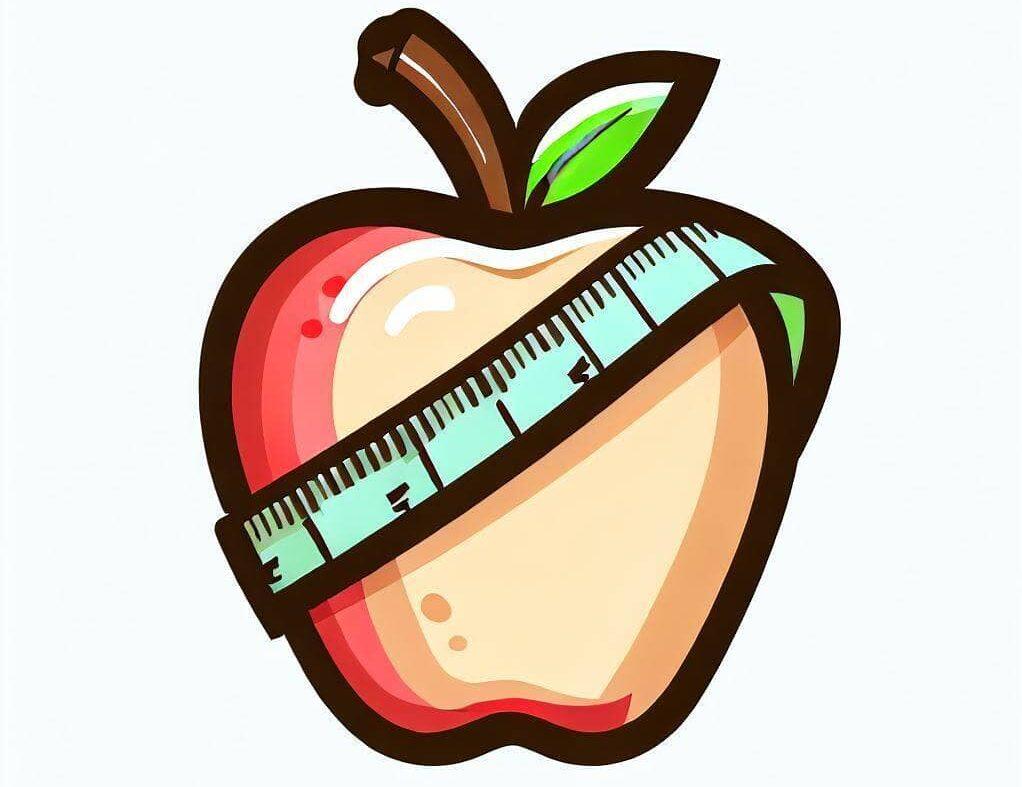Are Rice Noodles Good for Weight Loss?
This post may contain affiliate links which means I may receive a commission for purchases made through links at no extra cost to you. See my disclosure policy for more information.
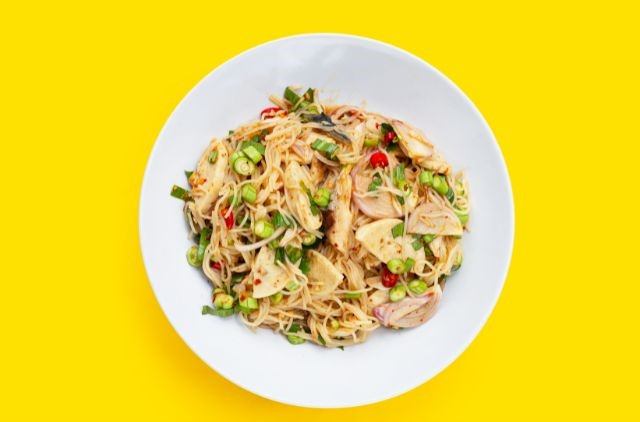
“Are rice noodles good for weight loss?”, No, rice noodles are not good for weight loss, because they are high in carbohydrates and low in fiber.
This means they can cause your blood sugar levels to rise and fall quickly, which can lead to hunger and cravings. They can also lead to increased storage of fat in your body, making it harder to lose weight.
As a nutritionist, I always educate my clients to watch out for foods that are high in carb content as they are energy-rich and when not eaten in moderation could hinder your weight loss efforts.
However, it’s not all doom and gloom, if you love rice noodles and still want to include them in your weight loss diet. We’ll find a way for you to do that. Let’s go.
Nutritional Value of Rice Noodles
As per the USDA, One cup (176 grams) of cooked rice noodles contains the following nutrients:
Serving Size: 1 cup (176 g)
- Calories: 190
- Protein: 3.2 g
- Carbs: 42.2 g
- Fiber: 1.8 g
- Fat: 0.4 g
Potential Benefits of Rice Noodles for Weight Loss
Low Sodium Content
Rice noodles are naturally low in sodium. Consuming foods low in sodium can help lower blood pressure and prevent fluid retention.
Excess sodium intake can lead to water weight gain, which can be mistaken for fat gain. Additionally, high sodium consumption increases the risk of heart disease and kidney disease.
With only 33.4 mg of sodium per cup (176 grams), rice noodles are well below the recommended daily limit of 1,500 mg, making them a heart-healthy choice.
Gluten-Free
Gluten is a protein found in wheat, barley, and rye. Some individuals have celiac disease, a condition where the ingestion of gluten leads to damage in the small intestine.
Others may have gluten sensitivities. Consuming gluten-free foods like rice noodles can prevent inflammation and bloating associated with gluten ingestion in these individuals.
Reduced inflammation and bloating can contribute to a more comfortable weight loss journey and better overall gut health.
Glycemic Index
The glycemic index (GI) is a measure of how quickly a food causes blood sugar levels to rise.
Foods with a high GI can cause rapid spikes in blood sugar, leading to a subsequent crash, which can trigger hunger and overeating.
Rice noodles have a moderate GI, meaning they release sugar into the bloodstream at a steadier rate, considering that you eat them in moderate amounts.
Calories and Serving Size
Weight loss fundamentally boils down to calories in versus calories out. Cooked rice noodles typically contain fewer calories per serving compared to some other types of pasta.
This means that you can consume a decent portion without significantly impacting your daily caloric intake.
By being mindful of portion sizes and pairing rice noodles with low-calorie, nutrient-dense foods, one can create satisfying meals that align with weight loss goals.
Provides a Good Source of Manganese and Selenium
Manganese and selenium are two essential minerals that play a crucial role in regulating blood sugar and reducing inflammation. Both these functions can indirectly support weight loss efforts.
A two-ounce serving of rice noodles provides 14% of the daily value (DV) of manganese and 12% of the DV of selenium, making them a valuable source of these minerals.
Also read: Are Aussie Bites Good for Weight Loss?
Potential Downsides of Eating Rice Noodles for Weight Loss
High in Carbs
Carbohydrates are the main source of energy for your body, but they also affect your blood sugar levels.
When you eat carbs, they are broken down into glucose, which is then absorbed into your bloodstream.
This causes your blood sugar levels to rise, which triggers the release of insulin. Insulin is a hormone that helps your cells take up glucose and use it for energy or store it for later use.
However, if you eat too many carbs, especially refined carbs like rice noodles, your blood sugar levels can spike and crash, causing a cycle of hunger and cravings.
This can make you eat more calories than you need and prevent you from feeling full and satisfied.
Lack of Fiber
Dietary fiber plays a crucial role in weight management. It adds bulk to our diet, helping us feel full and satisfied after meals, which can reduce overall calorie intake.
Fiber also supports healthy digestion by promoting regular bowel movements and feeding beneficial gut bacteria.
Rice noodles, being made primarily from rice flour, lack the significant fiber content found in whole-grain alternatives. This means they may not be as satiating, potentially leading to overeating.
Weight Gain Potential
Like any food, rice noodles can contribute to weight gain if consumed in excess.
While they have moderate calorie content, overindulging can still lead to a caloric surplus, where you consume more calories than you burn.
This surplus, over time, can result in weight gain. It’s essential to be mindful of portion sizes and overall daily caloric intake.
Low Nutrient Density
Nutrient density refers to the amount of essential nutrients a food provides relative to its calorie content.
While rice noodles offer some vitamins and minerals, they don’t pack the same nutrient punch as some other foods.
For those on a weight loss journey, it’s beneficial to prioritize nutrient-dense foods that provide a wide range of vitamins, minerals, and other beneficial compounds to support overall health and metabolism.
Potential for Unhealthy Additions
Rice noodles are often used in dishes that come with sauces and toppings high in added sugars, unhealthy fats, and sodium.
These additions can quickly turn a seemingly healthy dish into a calorie bomb, negating any potential weight loss benefits of the rice noodles themselves.
It’s essential to be aware of what’s being added to rice noodle dishes and opt for healthier, low-calorie options when possible.
Also read: Are English Muffins Good for Weight Loss?
Tips for Incorporating Rice Noodles Into a Weight Loss Diet
Stir Fry with Vegetables
Vegetables are packed with essential nutrients and are low in calories, making them ideal for weight loss.
When you use rice noodles in a vegetable-rich stir fry, you increase the meal’s overall fiber and nutrient content.
Fiber from vegetables adds bulk to the meal, promoting feelings of fullness and satiety. This can help reduce overall calorie intake, supporting weight loss efforts.
Watch the Serving Size
Portion control is a cornerstone of effective weight management. Consuming controlled portions ensures that you’re not inadvertently eating more calories than you need.
By being mindful of the amount of rice noodles per serving, you can enjoy them without significantly impacting your daily caloric intake, thus aiding in weight loss.
Pair with Protein
Protein is known for its satiating properties.
It helps in muscle repair and growth and can also increase the thermic effect of food (the energy required to digest and process food).
By combining rice noodles with lean proteins like chicken, tofu, or fish, you can create a balanced meal that helps you feel full longer, reducing the likelihood of overeating later.
Also read: Is Spam Good for Weight Loss?
Limit Added Fats
While dietary fats are essential for various bodily functions, they are calorie-dense, providing 9 calories per gram.
While rice noodles themselves are low in fat, the dishes they’re incorporated into might be cooked with oils or paired with fatty sauces.
By opting for healthier cooking methods like steaming or boiling and limiting added oils and sauces, you can control the fat content and overall calorie count of your meal.
Choose Broth-Based Dishes
Broth-based dishes, like soups or stews, tend to be lower in calories compared to creamy or fried dishes.
The high water content in broths provides volume without adding many calories, helping you feel full with fewer calories.
Incorporating rice noodles into broth-based dishes can be a flavorful way to enjoy them while aligning with weight loss goals.
Opt for Whole Grain or Brown Rice Noodles
If available, choosing whole grain or brown rice noodles can be a better option.
These noodles retain the bran and germ of the rice grain, offering more fiber and nutrients than their white rice counterparts. The added fiber can promote feelings of fullness, potentially aiding in weight loss.
Alternatives to Rice Noodles For Weight Loss
Whole Wheat Noodles
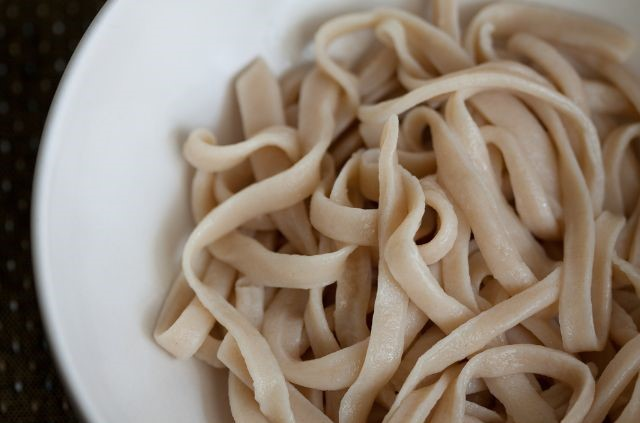
Whole wheat noodles are made from whole wheat flour, which retains the bran, germ, and endosperm of the wheat grain.
This means they are richer in dietary fiber compared to white or rice noodles. Fiber is known to promote feelings of fullness, which can help reduce overall calorie intake.
Additionally, whole wheat noodles have a lower glycemic index, leading to slower rises in blood sugar and sustained energy.
Vermicelli (Mung Bean Noodles)
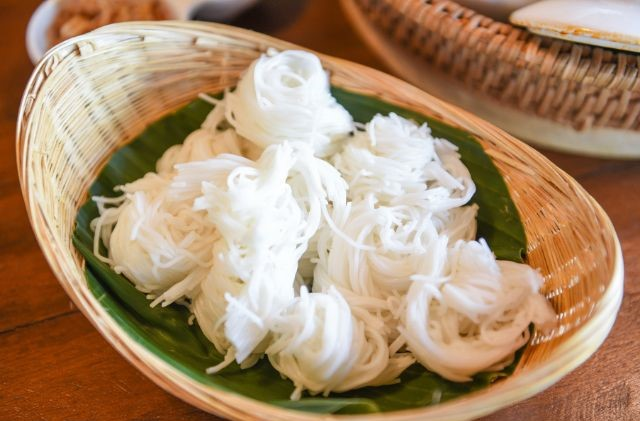
Vermicelli, often made from mung beans, is another gluten-free option. Mung bean noodles are low in calories and fat.
They also have a unique texture that can be a refreshing change from regular noodles. However, like rice noodles, they are relatively low in fiber, so it’s essential to pair them with fiber-rich foods for satiety.
Whole Grain Pasta
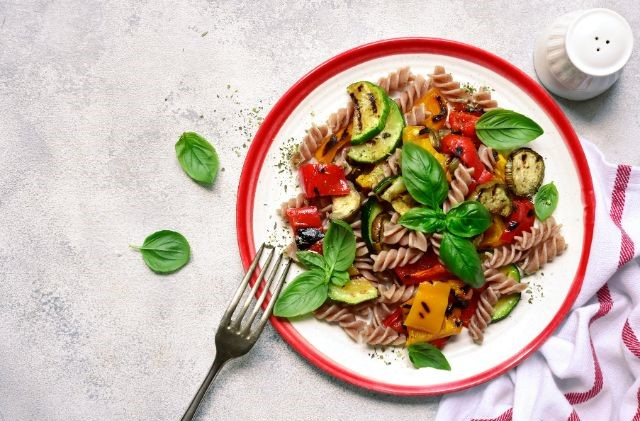
Similar to whole wheat noodles, whole grain pasta is made from grains that retain all parts of the seed (bran, germ, and endosperm).
This results in a higher fiber content, which aids in digestion and promotes feelings of fullness.
Whole grain pasta also contains more vitamins and minerals than refined pasta, supporting overall health during weight loss.
Also read: Best Time to Eat Pasta for Weight Loss
Zucchini Noodles (Zoodles)
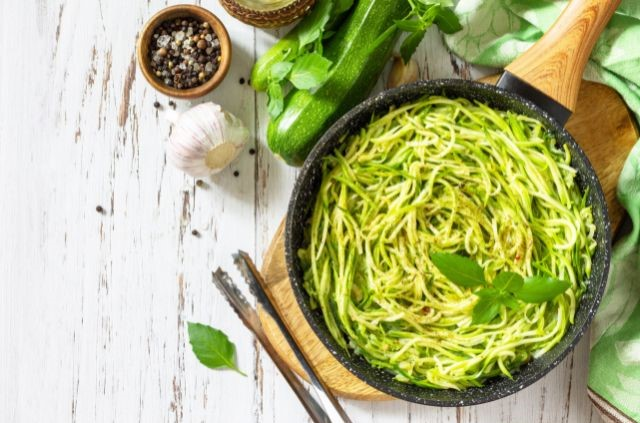
Zoodles are made by spiralizing zucchini into noodle-like strands. They are incredibly low in calories and carbohydrates, making them a popular choice for those on low-carb or calorie-restricted diets.
Zoodles also provide essential nutrients like vitamin C, potassium, and antioxidants. Their high water content can help you feel full with fewer calories.
Shirataki Noodles
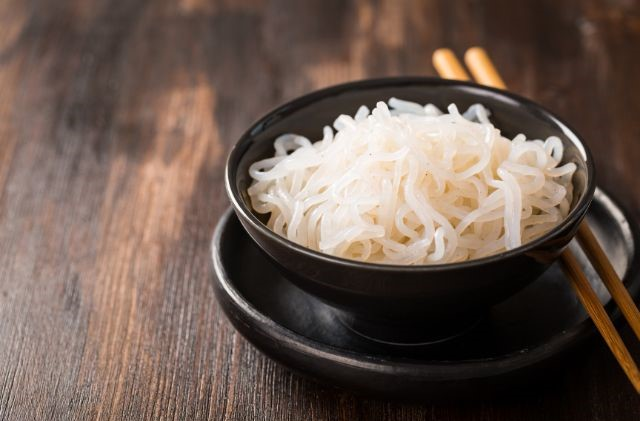
Shirataki noodles are made from the konjac plant’s root and are primarily composed of a soluble fiber called glucomannan.
They are virtually calorie-free and carb-free, making them a favorite among those looking to lose weight.
Glucomannan can absorb water and expand in the stomach, promoting feelings of fullness and potentially reducing food intake.
Spaghetti Squash

When cooked, the flesh of spaghetti squash separates into noodle-like strands. It’s a low-calorie, low-carb alternative to traditional pasta and noodles.
Rich in vitamins and minerals like vitamin A, vitamin C, and potassium, spaghetti squash can be a nutritious addition to a weight loss diet.
Conclusion
There is no denying that rice noodles are a high-carb food and since carbohydrates’ job is to provide the body with energy, it does not fit with your weight loss goals.
I am not saying that eating carbs is bad. Nope. Carbs are necessary but the key term is “in moderation”. Also, it depends on your lifestyle.
If you live an active lifestyle where you exercise 3 – 4 times a week as compared to someone who lives a sedentary life with virtually no physical activity, both these people will have completely different carb requirements.
So as long as you eat rice noodles in moderation and pair them with high-fiber foods, you can still enjoy them on occasion without derailing your weight loss efforts.
Speak to your nutritionist about how much carbs you should be eating.
FAQ
Are rice noodles healthy?
Yes, rice noodles can be healthy when consumed in moderation and as part of a balanced diet.
Are rice noodles fattening?
No, rice noodles are not inherently fattening, but overconsumption of carbs without having an active lifestyle may lead to those carbs being stored as fat.
Which is healthier, rice or noodles?
It depends on the type of noodles. Whole grain noodles are generally healthier than white rice due to higher fiber content. However, both can be part of a healthy diet when consumed in moderation.
How many carbs are in rice noodles?
Approximately 42 grams of carbs per 1 cup of cooked rice noodles.
Are rice noodles healthier than pasta?
It depends on the type of pasta. Rice noodles are gluten-free and may be a better option for those with gluten sensitivities. However, whole-grain pasta offers more fiber and nutrients than rice noodles.
Can rice noodles help you lose weight?
Rice noodles can be part of a weight loss diet when consumed in moderation and paired with other nutrient-rich foods. However, they are not a magic weight loss food on their own.
This post may contain affiliate links which means I may receive a commission for purchases made through links at no extra cost to you. See my disclosure policy for more information.
Rahul is a professional nutritionist certified by the International Sports Sciences Association (ISSA) and a personal trainer certified through the American Council of Exercise (ACE). He has a special interest in the science of nutrition and how it can impact the body.
